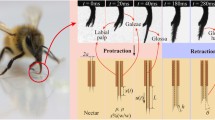Abstract
A honeybee uses its brush-like tongue (glossa) to dip nectar and the setae densely distributed on it can increase the amount of trapped nectar observably. The glossa is often simplified as a cylinder covered by uniformly distributed and vertically erected setae during the drinking process, herein variations of the dimensions together with the erection angles of glossal setae are assumed to be negligible. In this paper, a dynamic model for the glossa retraction phase under the specific erection pattern of glossal setae is established, and the energy saving mechanism is extensively studied by comparing four types of erection patterns. Then the theoretically-optimal configuration, which satisfies the minimum energy consumption, is achieved from the dynamic model. Using the scanning electron microscope and a specially-designed high-speed camera system, we measure the dimensions of the glossal satae and capture dynamics of the hairy glossa in nectar feeding. It is proven that the erection angle of the glossal setae varies along the tongue axis, which shows a high concordance with our theoretically-optimal configuration. Compared with the hypothetical uniform distribution mode of glossal setae proposed by former researchers, we obtain a 16% increase in energy saving from actual erection pattern.
Similar content being viewed by others
References
Ren H, Wang X, Li X, Chen Y. Effects of dragonfly wing structure on the dynamic performances. Journal of Bionic Engineering, 2013, 10, 28–38.
Kim W, Bush J W M. Natural drinking strategies. Journal of Fluid Mechanics, 2012, 705, 7–25.
Reis P M, Jung S, Aristoff J M, Stocker R. How cats lap: Water uptake by Felis catus. Science, 2010, 330, 1231–1234.
Crompton A W, Musinsky C. How dogs lap: Ingestion and intraoral transport in Canis familiaris. Biology Letters, 2011, 7, 882–884.
Harper C J, Swartz S M, Brainerd E L. Specialized bat tongue is a hemodynamic nectar mop. Proceedings of the National Academy of Sciences, 2013, 110, 8852–8857.
Lehnert M S, Brown E, Lehnert M P, Gerard P D, Yan H, Kim C. The golden ratio reveals geometric differences in proboscis coiling among butterflies of different feeding gabits. American Entomologist, 2015, 61, 18–26.
Cundall D, Brainerd E L, Constantino J, Deufel A, Grapski D, Kley N J. Drinking in snakes: Resolving a biomechanical puzzle. Journal of Experimental Zoology Part A: Ecological Genetics and Physiology, 2012, 317, 152–172.
Kong X Q, Wu C W. Mosquito proboscis: An elegant biomicroelectromechanical system. Physical Review E, 2010, 82, 011910.
Amirouche F, Zhou Y, Johnson T. Current micropump technologies and their biomedical applications. Microsystem Technologies, 2009, 15, 647–666.
Klowden M J. Physiological Systems in Insects, 3rd ed, Academic Press, Burlington, 2013.
Wu J, Zhu R, Yan S, Yang Y. Erection pattern and section- wise wettability of a honeybee’s glossal hairs in nectar feeding. Journal of Experimental Biology, 2015, 218, 664–667.
Kim W, Tristan G, and Bush J W M. Optimal concentrations in nectar feeding. Proceedings of the National Academy of Sciences, 2011, 108, 16618–16621.
Quéré D. Fluid coating on a fiber. Annual Review of Fluid Mechanics, 1999, 31, 347–384.
Yang H, Wu J, Yan S. Effects of erectable glossal hairs on a honeybee’s nectar-drinking strategy. Applied Physics Letters, 2014, 104, 263701.
Snodgrass R E. Anatomy of the Honey Bee, Comestock Publishing Association, New York, 1956.
Li C, Wu J, Yang Y, Zhu R, Yan S. Drag reduction in the mouthpart of a honeybee facilitated by galea ridges for nectar-dipping strategy. Journal of Bionic Engineering, 2015, 12, 70–78.
Rabets Y, Backholm M, Dalnoki-Veress K, Ryu W S. Direct measurements of drag forces in C. elegans crawling locomotion. Biophysical Journal, 2014, 107, 1980–1987.
Cheer A Y L, Koehl M A R. Paddles and rakes: Fluid flow through bristled appendages of small organisms. Journal of Theoretical Biology, 1987, 129, 17–39.
Vogel S. Comparative Biomechanics: Life’s Physical World, Princeton University Press, New Jersey, 2013.
Gupta K M, Montezemi A R. Empirical evaluation of retrieval in case-based reasoning systems using modified cosine matching function. IEEE Transactions on Systems, Man and Cybernetics, Part A: Systems and Humans, 1997, 27, 601–612.
Zhao J, Wu J, Yan S. Erection mechanism of glossal hairs during honeybee feeding. Journal of Theoretical Biology, 2015, 386, 62–68.
Wu J, Yang H, Yan S. Energy saving strategies of honeybees in dipping nectar. Scientific Reports, 2015, doi: 10.1038/srep15002.
Author information
Authors and Affiliations
Corresponding author
Rights and permissions
About this article
Cite this article
Zhao, Y., Wu, J., Yang, H. et al. The morphology and reciprocation movement of honeybee’s hairy tongue for nectar uptake. J Bionic Eng 13, 98–107 (2016). https://doi.org/10.1016/S1672-6529(14)60163-3
Published:
Issue Date:
DOI: https://doi.org/10.1016/S1672-6529(14)60163-3




